Abstract
The effects of inbreeding on the incidence of congenital anomalies and measurement at birth of offspring were explored on the basis of a prospective survey done during 1969 to 1974. The pregnancies of over 20 000 married women from rural and urban samples in North Arcot District were identified and followed up through routine home visiting once every 5 weeks by qualified women investigators. Of all marriages, 47% in the rural areas and 29% in the urban were consanguineous. The average inbreeding coefficients in the rural and urban areas were 0·0371 and 0·0204, respectively; these are significantly higher than those prevalent in most parts of the world.
For purposes of statistical analysis, marriages were classified into four groups based on degree of consanguinity. Women in these four marriage groups were similar in terms of major social, economic, and other demographic factors, and in maternal variables, such as the time since the last pregnancy, place of delivery, and attendant at delivery.
No significant differences existed in the incidence of congenital anomalies among offspring between the consanguineous and non-consanguineous marriages in the rural or in the urban area. Neither were any significant trends seen by degree of consanguinity, or by birth order, or by the different age groups. The types of malformations and their frequency seen in the consanguineous and non-consanguineous groups were similar. There were also no significant differences observed by type of marriage in both areas in gestational age, birthweight, body length, head circumference, or chest circumference. The fitting of exponential curves relating inbreeding coefficients to these indices led to regressions that do not attain statistical significance. It is suggested that long term inbreeding does not lead to appreciable effects on fetal growth and development.
Full text
PDF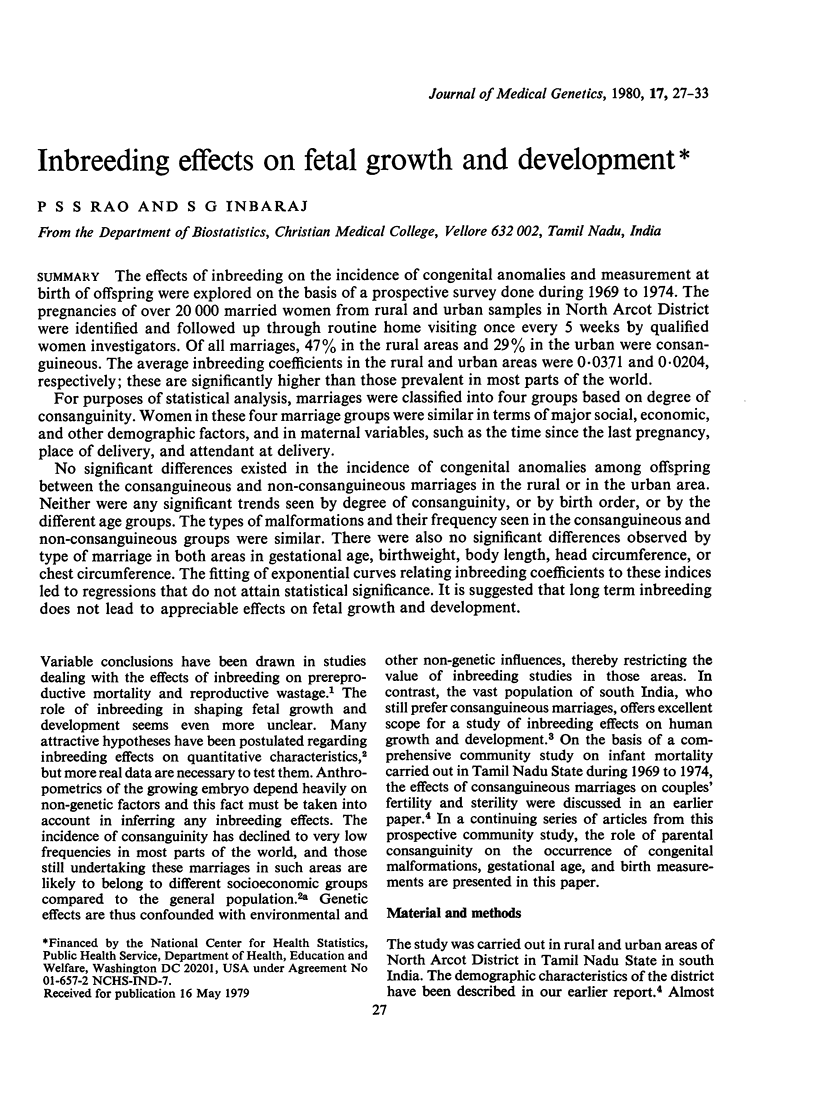
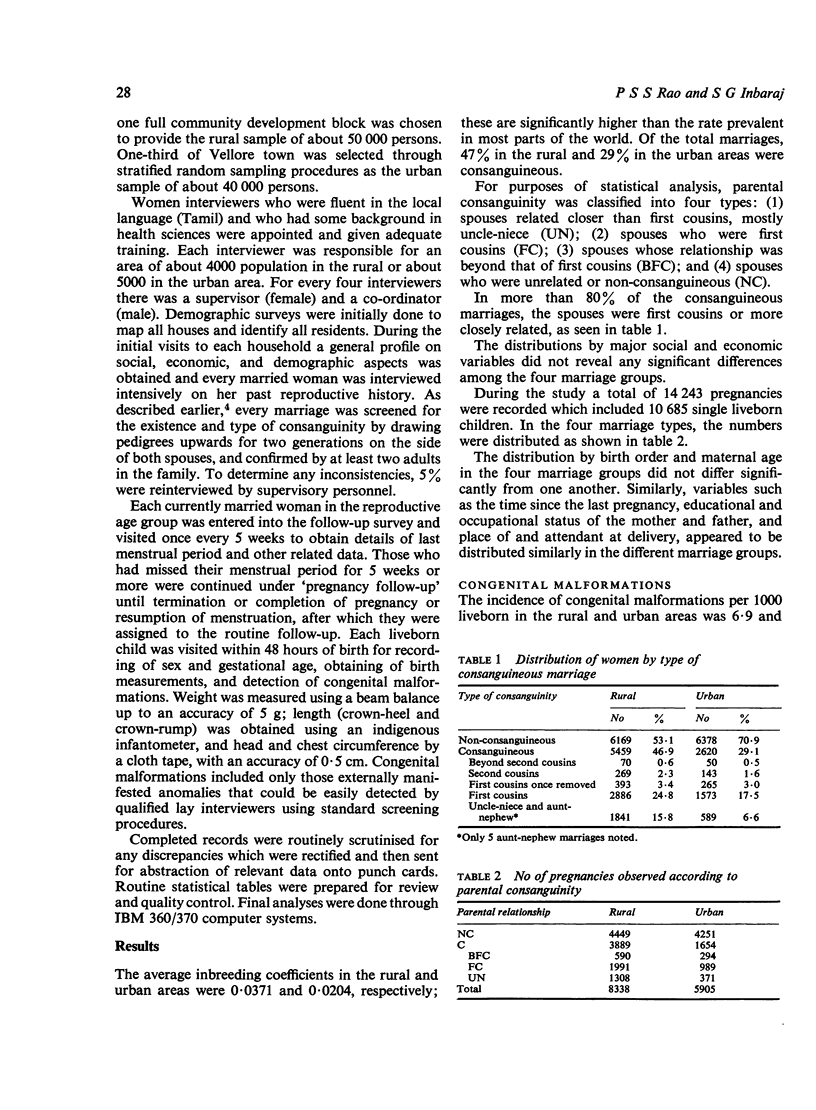
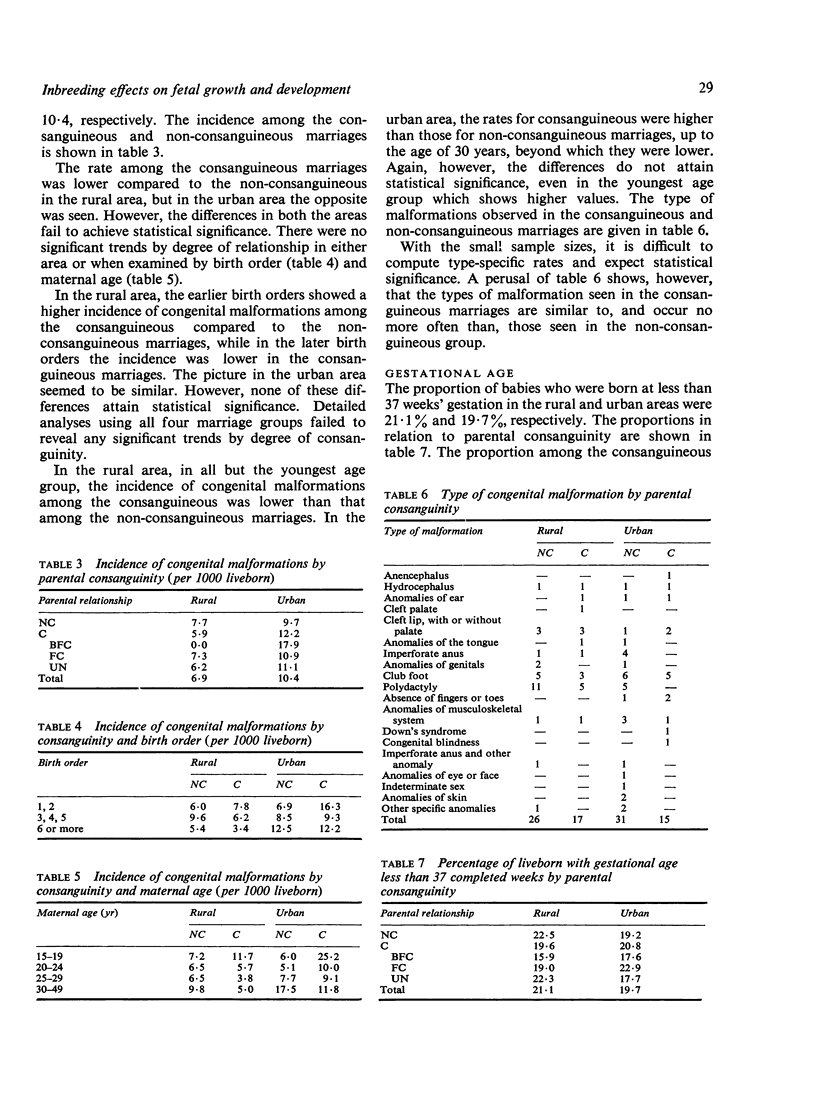
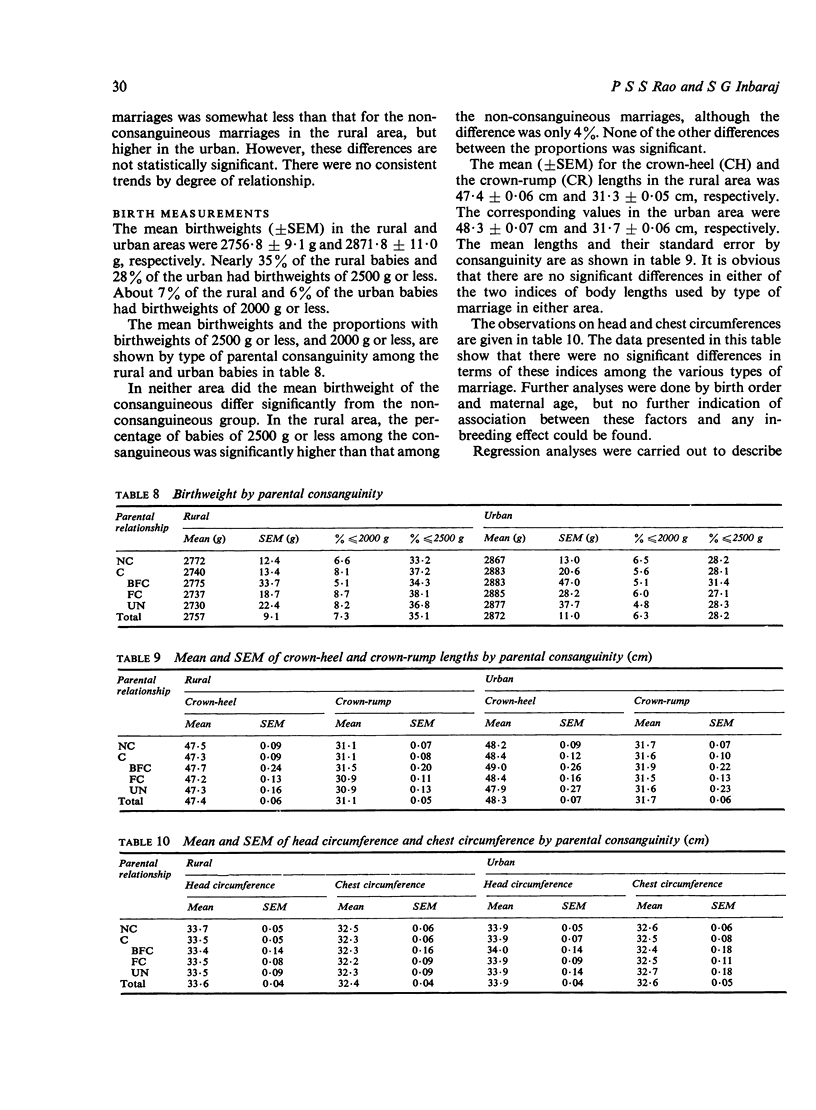
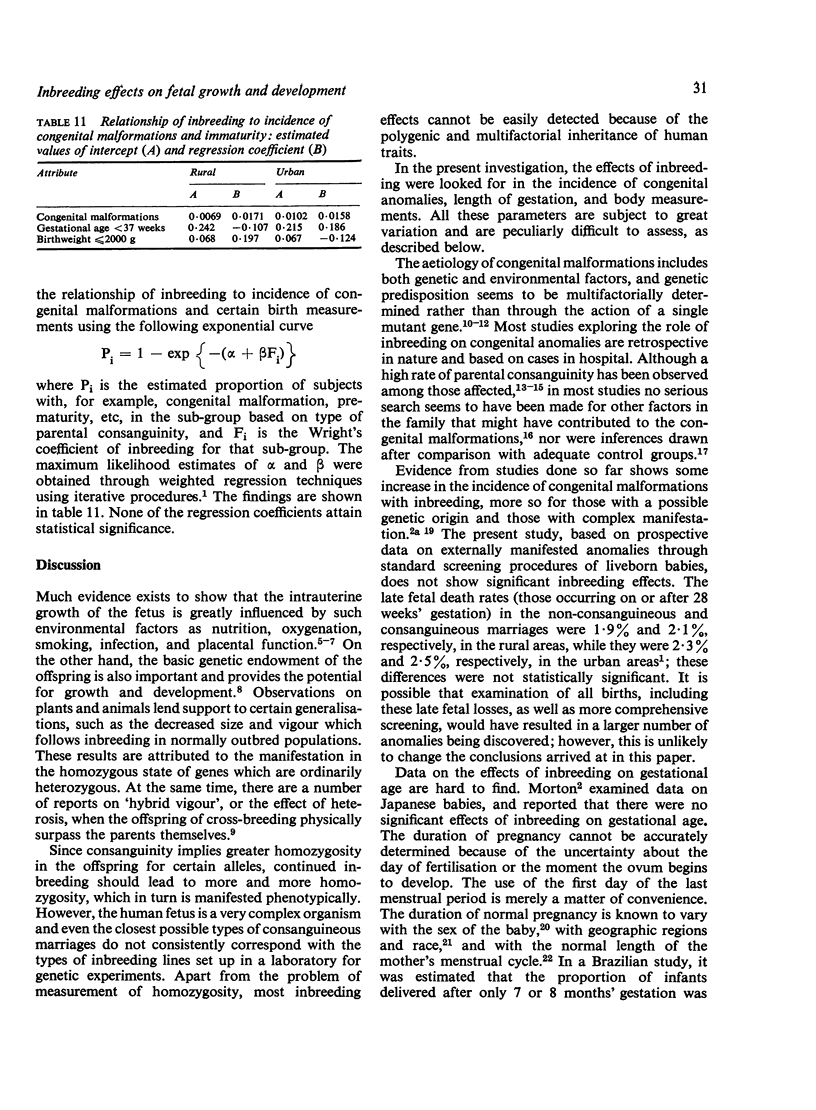
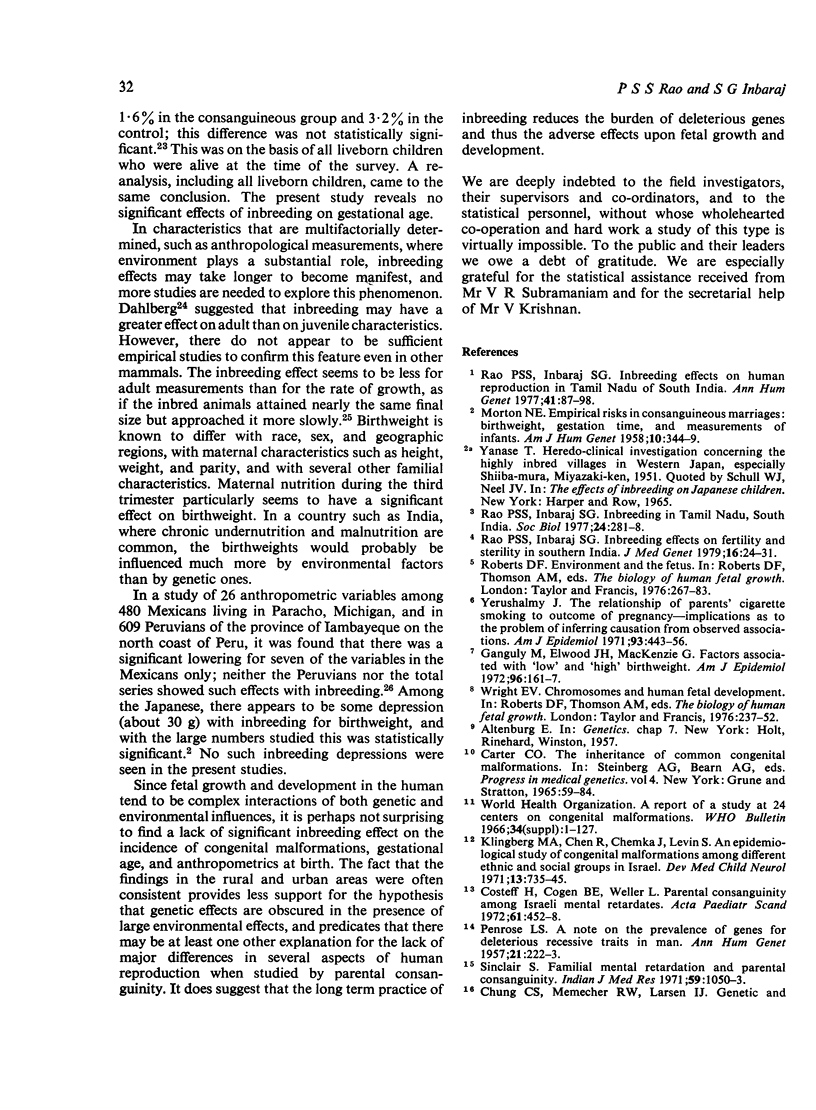

Selected References
These references are in PubMed. This may not be the complete list of references from this article.
- Centerwall W. R., Centerwall S. A. Consanguinity and congenital anomalies in South India: a pilot study. Indian J Med Res. 1966 Dec;54(12):1160–1167. [PubMed] [Google Scholar]
- Chung C. S., Nemechek R. W., Larsen I. J., Ching G. H. Genetic and epidemiological studies of clubfoot in Hawaii. General and medical considerations. Hum Hered. 1969;19(4):321–342. doi: 10.1159/000152236. [DOI] [PubMed] [Google Scholar]
- Costeff H., Cohen B. E., Weller L. Parental consanguinity among Israeli mental retardates. Acta Paediatr Scand. 1972 Jul;61(4):452–458. doi: 10.1111/j.1651-2227.1972.tb15863.x. [DOI] [PubMed] [Google Scholar]
- Dahlberg G. Inbreeding in Man. Genetics. 1929 Sep;14(5):421–454. doi: 10.1093/genetics/14.5.421. [DOI] [PMC free article] [PubMed] [Google Scholar]
- Erhardt C. L., Chase H. C. A study of risks, medical care, and infant mortality. 2. Ethnic group, education of mother, and birth weight. Am J Public Health. 1973 Sep;63 (Suppl 9):17–26. doi: 10.2105/ajph.63.9_suppl.17. [DOI] [PMC free article] [PubMed] [Google Scholar]
- Ganguly M., Elwood J. H., MacKenzie G. Factors associated with "low" and "high" birth weight. Am J Epidemiol. 1972 Aug;96(2):161–167. doi: 10.1093/oxfordjournals.aje.a121442. [DOI] [PubMed] [Google Scholar]
- John T. J., Jayabal P. Foetal and child loss in relation to consanguinity in Southern India. Indian J Med Res. 1971 Jul;59(7):1050–1053. [PubMed] [Google Scholar]
- Klingberg M. A., Chen R., Chemke J., Levin S. An epidemiologic study of congenital malformations among different ethnic and social groups in Israel. Dev Med Child Neurol. 1971 Dec;13(6):735–745. doi: 10.1111/j.1469-8749.1971.tb08346.x. [DOI] [PubMed] [Google Scholar]
- Lasker G., Kaplan B. Anthropometric variables in the offspring of isonymous matings. Hum Biol. 1974 Dec;46(4):713–717. [PubMed] [Google Scholar]
- MARCALLO F. A., FREIRE-MAIA N., AZEVEDO J. B., SIMOES I. A. INBREEDING EFFECT ON MORTALITY AND MORBIDITY IN SOUTH BRAZILIAN POPULATIONS. Ann Hum Genet. 1964 Mar;27:203–218. doi: 10.1111/j.1469-1809.1963.tb00787.x. [DOI] [PubMed] [Google Scholar]
- MORTON N. E. Empirical risks in consanguineous marriages: birth weight, gestation time, and measurements of infants. Am J Hum Genet. 1958 Sep;10(3):344–349. [PMC free article] [PubMed] [Google Scholar]
- PENROSE L. S. A note on the prevalence of genes for deleterious recessive traits in man. Ann Hum Genet. 1957 Mar;21(3):222–223. doi: 10.1111/j.1469-1809.1972.tb00283.x. [DOI] [PubMed] [Google Scholar]
- Rao P. S., Inbaraj S. G. Inbreeding effects on fertility and sterility in southern India. J Med Genet. 1979 Feb;16(1):24–31. doi: 10.1136/jmg.16.1.24. [DOI] [PMC free article] [PubMed] [Google Scholar]
- Rao P. S., Inbaraj S. G. Inbreeding effects on human reproduction in Tamil Nadu of South India. Ann Hum Genet. 1977 Jul;41(1):87–98. doi: 10.1111/j.1469-1809.1977.tb01964.x. [DOI] [PubMed] [Google Scholar]
- Rao P. S., Inbaraj S. G. Inbreeding in Tamil Nadu, South India. Soc Biol. 1977 Winter;24(4):281–288. doi: 10.1080/19485565.1977.9988298. [DOI] [PubMed] [Google Scholar]
- SCHULL W. J. Empirical risks in consanguineous marriages: sex ratio, malformation, and viability. Am J Hum Genet. 1958 Sep;10(3):294–343. [PMC free article] [PubMed] [Google Scholar]
- Yerushalmy J. The relationship of parents' cigarette smoking to outcome of pregnancy--implications as to the problem of inferring causation from observed associations. Am J Epidemiol. 1971 Jun;93(6):443–456. doi: 10.1093/oxfordjournals.aje.a121278. [DOI] [PubMed] [Google Scholar]


